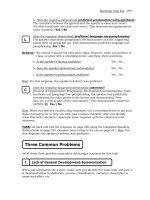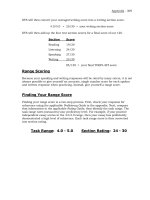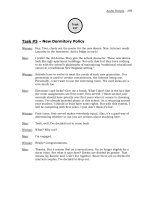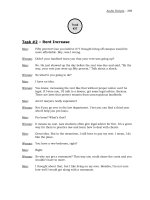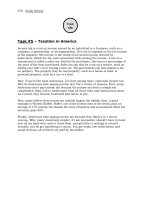Tài liệu Speaking and Writing Strategies for the TOEFL iBT part 26 pptx
Bạn đang xem bản rút gọn của tài liệu. Xem và tải ngay bản đầy đủ của tài liệu tại đây (306.69 KB, 10 trang )
Speaking Task Three - 239
Directions: New Canaan University is implementing a new policy. Read the
announcement. You have 45 seconds.
Next, listen as two students discuss the new policy.
After you listen to the dialogue, answer the new policy.
TASK: You have 30 seconds to prepare your response and 60 seconds to speak.
Prompt The man expresses his opinion about the new policy. State his
position and explain the reasons he gives for expressing that
opinion.
Announcement from the President
Starting next semester, all first and second year students will be required to
live on campus in a dormitory. The university has recently finished
construction of the Joan Lily Dormitory and the Dr. S. G. Shiloh Dormitory.
These state-of-the-art dorms each contain 500 rooms with laundry facilities
and exercising rooms in the basements. Each room has two beds and a
small refrigerator. All rooms are internet ready, have card key locks, and
provide wonderful views of Lake Barley. Rooms and roommates will be
assigned on a first-come, first-served basis. The Dr. S. G. Shiloh dormitory
is for male students only. The Joan Lily dormitory is for female students
only. If you have any questions, please contact the university president.
Task #5
CD
Track
#17
240 - Speaking Task Three
Directions: Westport University is implementing a new policy. Read the
announcement. You have 45 seconds.
Next, listen as two students discuss the new policy.
After you listen to the dialogue, answer the prompt.
TASK: You have 30 seconds to prepare your response and 60 seconds to speak.
Prompt The woman expresses her opinion about the new policy. State
her opinion and explain the reasons she gives for expressing that
opinion.
Announcement from the Dean
In celebration of this the Year of the Volunteer, Westport University is
pleased to announce the following. Starting next semester, each student
will be required to be a volunteer for one full semester. Students may
choose which organization they would like to volunteer for. Volunteering for
work related to your major is recommended but not required. However, a
minimum of four hours a week volunteering is required. You will receive
credit for your work as a volunteer. The required minimum number of
volunteer hours is forty-eight per student. Volunteering is a requirement for
graduation. If you have any questions about this policy, please contact the
Dean’s office.
Task #6
CD
Track
#18
Speaking Task Three - 241
In this chapter, you learned how to develop, revise and deliver integrated spoken
responses using G+3TiC=C
and the four steps. By doing so, you can demonstrate
OPDUL=C
in your response.
Test-takers who get high integrated speaking scores have practiced
speaking a lot.
What Have You Learned?
Remember!
Make a note map; summarize the reading (45 seconds).
#1
Summarize the dialogue (60-90 seconds).
#2
Read the prompt.
#3
Prepare your response (30 seconds).
#4
Speak (60 seconds).
#5
242 - Speaking Task Three
_________________________________________________________________________________
_________________________________________________________________________________
_________________________________________________________________________________
_________________________________________________________________________________
_________________________________________________________________________________
_________________________________________________________________________________
_________________________________________________________________________________
_________________________________________________________________________________
_________________________________________________________________________________
_________________________________________________________________________________
_________________________________________________________________________________
_________________________________________________________________________________
_________________________________________________________________________________
_________________________________________________________________________________
_________________________________________________________________________________
_________________________________________________________________________________
_________________________________________________________________________________
_________________________________________________________________________________
_________________________________________________________________________________
_________________________________________________________________________________
_________________________________________________________________________________
_________________________________________________________________________________
_________________________________________________________________________________
_________________________________________________________________________________
_________________________________________________________________________________
_________________________________________________________________________________
_________________________________________________________________________________
_________________________________________________________________________________
_________________________________________________________________________________
_________________________________________________________________________________
Notes
Speaking Task Four - 243
Speaking task four is a fact-based argument. For this task, you will integrate three
skills: reading, listening and speaking objectively. The task order follows.
For this task, you must:
take notes as you read and listen;
summarize the main points in the reading and in the lecture;
synthesize the main points in the reading and in the lecture;
paraphrase the main points in the reading and in the lecture.
You can develop and deliver a response for this task using G+3TiC=C. This
argument map will help you take notes and give the speaking raters what they are
trained to listen for: a coherent integrated spoken response that demonstrates
OPDUL=C
(see the Integrated Speaking Proficiency Checklist page 322).
Understanding ETS’s testing method for this task is the first step in delivering a
coherent integrated spoken response. Begin by reading the sample reading passage
on the next page. You have 45 seconds.
Speaking Task Four
Integrated Task: Read-Listen-Speak
Task Time
1. Read a short academic passage. 45 seconds
2. Listen to a short lecture about
the topic in the reading.
60-90 seconds
4. Prepare your response. 30 seconds
5. Deliver your response. 60 seconds
ETS’s Testing Method
3. Read the prompt.
244 - Speaking Task Four r
Next, read along as you listen to a sample lecture on the same topic.
In this lecture, the professor develops two examples of a nocturnal animal: the
mega bat and the micro bat. These examples “add to and support” (develop) the
premise in the reading: “Animal behavior can be classified according to the time of
day an animal is active.”
Animal behavior can be classified according to the time of day
an animal is active. Animals, such as horses, elephants and
most birds, are said to be diurnal because they are active
during the day and rest at night. Those animals active at dawn
and dusk are said to be crepuscular. Beetles, skunks and
rabbits fall into this category. The third group are those
animals that sleep during the day and are active at night. They
are called nocturnal. A good example is the bat. Bats have
highly developed eyesight, hearing and smell. This helps them
avoid predators and locate food. Being nocturnal also helps
them avoid high temperatures during the day, especially in
deserts where temperatures can reach well over one hundred
degrees Fahrenheit.
Good afternoon. In this lecture, we’ll focus on a common
nocturnal animal, the bat. There are two types of bat: micro
bats, or true bats, and mega bats, also called fruit bats. Let’s
start with mega bats. Size wise, mega bats are from two to
sixteen inches in length. Mega bats have extremely sensitive
sight and smell. This helps them locate the flowers and fruit
upon which they feed. It is while eating that mega bats play a
important role in the distribution of plants. Like bees, mega
bats serve as pollinators. When they lick nectar or eat flowers,
their bodies become covered in pollen which they, in turn,
carry to other trees and plants thereby acting as pollinators. In
fact, many of the fruits and vegetables on our tables, such as
bananas and peaches, would not be there if mega bats did not
pollinate plants and trees.
Next are micro bats. As the name implies, micro bats are
quite small, about the size of a mouse. To find food, micro bats
use echolocation, high frequency sounds they bounce off
insects. The most common micro bat is the vesper or evening
bat. Like mega bats, micro bats play an important role in the
environment. The average vesper bat, for example, can eat
one thousand mosquitoes in one night. By doing so, they
control the mosquito population.
CD
Track
#9
Speaking Task Four - 245
Mapped out, you can see how the reading and the lecture are organized. Notice
how G
is the premise, a general statement that introduces the main topic.
G = premise = general
TiC = example = specific
TiC = example = specific add to + support
C = conclusion = general
ETS uses this testing method for the show-support integrated essay as well.
Because ETS recycles the same testing method for this task, you can summarize
the reading and the lecture, and map out your response using G+3TiC=C
.
Are there always two lecture examples (2TiC) to support the reading?
No. Sometimes there is only one example (TiC). Sometimes there are two
examples (2TiC). Sometimes three (3TiC). Be prepared for three examples.
When developing and delivering a response for this task, use G+3TiC=C and the
following five steps to demonstrate OPDUL=C
in your response.
First, the narrator will give instructions.
As you listen to the narrator, make a note map. Put R for reading at the top. Under
R
, put L for lecture. Because time is limited, simply number each body paragraph.
Narrator: Read the following passage on animal behavior. You
have 45 seconds. Begin reading now.
reading
lecture
Q
A
Developing a Response: Step-by-Step
Make a note map; read and summarize the reading.
Step #1
246 - Speaking Task Four r
When the narrator finishes speaking, a countdown clock will appear on your
screen. The clock will countdown (45, 44, 43…). As you read, look for signal words
such as:
definition…define…classify…classification…process…historical
figure…historical moment… idea…concept…theory…design…
These signal words will help you identify the premise.
Identifying and summarizing the premise is your first task. The premise is the
main topic. It will be stated in the topic sentence. The premise will be expressed
using a rhetorical strategy. For example, a date in the premised will signal the
rhetorical strategy of narration. Narration, in turn, will signal the start of a general
description of an historical person or event, for example:
In 1878, Thomas Edison formed the Edison Electric Light Company in New
York City.
The premise might also employ the rhetorical strategy of process.
Making microprocessors is a complicated process. First, you must…
The premise might also employ the rhetorical strategy of description.
J. D. Salinger, an eccentric recluse, penned The Catcher in the Rye, a
coming-of-age novel in which a young hero rebels against the world.
R
G
L
1
2
3
C
Identifying the Main Topic
Speaking Task Four - 247
The premise might also employ the rhetorical strategy of cause-and-effect.
Training a cat is next to impossible.
The premise might also employ the rhetorical strategy of definition.
Estrogen is a hormone found in both men and women.
The premise might also employ the rhetorical strategy of definition and cause-and-
effect.
Estrogen is a hormone found in both men and women; however, its
function in men is not entirely understood.
The premise might also employ the rhetorical strategy of classification.
Animal behavior can be classified according to the time of day an animal
is active.
Read the sample passage once again. Notice how the premise is stated in the topic
sentence and is identified by the rhetorical signal words can be classified
followed
by a description of the classifying process.
Next, summarize the reading under R on your note map. To summarize means to
identify and generally describe the main points. In the sample reading, the main
points are the premise (classifying animal behavior) and a general description of
each animal classification.
Animal behavior can be classified according to the time of
day an animal is active. Animals, such as horses, elephants
and most birds, are said to be diurnal because they are active
during the day and rest at night. Those animals active at dawn
and dusk are said to be crepuscular. Beetles, skunks and
rabbits fall into this category. The third group are those
animals that sleep during the day and are active at night. They
are called nocturnal. A good example is the bat. Bats have
highly developed eyesight, hearing and smell. This helps them
avoid predators and locate food. Being nocturnal also helps
them avoid high temperatures during the day, especially in
deserts where temperatures can reach well over one hundred
degrees Fahrenheit.
248 - Speaking Task Four r
Do not summarize every sentence in the reading. You will waste time.
You only have 45 seconds. Only summarize the main topic.
The reading passage will not return after you read it. That means you
must summarize it at this point.
When the reading ends, it will be replaced by the lecture. It will last 60-90 seconds.
Read along as you listen to the sample lecture. As you listen, summarize the main
points of the lecture under L
on your note map.
R
G animal behavior classified according to time of day
day is diurnal – eat during day, sleep at night, humans
horses, elephants
twilight is crepuscular – active dawn and dusk, beetles,
rabbits, skunks
night is nocturnal – sleep during day, active at night
Listen to the lecture; summarize it.
Step #2
Remember!
Remember!
Narrator: Listen to a lecture on animal behavior.
Good afternoon. In this lecture, we’ll focus on a common
nocturnal animal, the bat. There are two types of bat: micro
bats, or true bats, and mega bats, also called fruit bats. Let’s
start with mega bats. Size wise, mega bats range from two to
sixteen inches in length. Mega bats have extremely sensitive
sight and smell. This helps them locate the flowers and fruit
upon which they feed. It is while eating that mega bats play a
important role in the distribution of plants. Like bees, mega
bats serve as pollinators. When they lick nectar or eat flowers,
their bodies become covered in pollen which they, in turn,
carry to other trees and plants thereby acting as pollinators. In
fact, many of the fruits and vegetables on our tables, such as
bananas and peaches, would not be there if mega bats did not
pollinate plants and trees.
(continued on the next page)
CD
Track
#9
